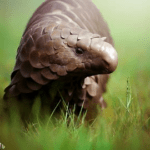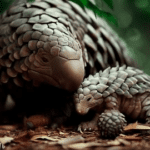Are Pangolins Marsupials? Pangolins are not marsupials! They belong to the order Pholidota, while marsupials belong to Marsupialia. Pangolins are found in Africa and Asia. They have a unique diet of ants and termites, and they use their long tongues that can extend up to 16 inches to catch their prey. Plus, they have strong claws for digging burrows and protecting themselves.
Sadly, pangolins are highly trafficked mammals on the black market due to their scales. This illegal trade is a threat to their survival, leading to a decline in their populations.
Key Takeaways
- Pangolins are not marsupials; they are mammals.
- Marsupials are a distinct group of mammals that give birth to relatively undeveloped young and carry them in a pouch.
- Pangolins, on the other hand, are placental mammals that give birth to fully developed young.
- Despite their differences, both pangolins and marsupials play important roles in their respective ecosystems.
- Pangolins are known for their unique scales and are often hunted for their meat and scales, leading to their decline in many parts of the world.
- Understanding the differences between different groups of mammals, such as marsupials and placental mammals like pangolins, is important for conservation efforts and maintaining biodiversity.
Background on pangolins

Pangolins, otherwise known as scaly anteaters, are amazing creatures belonging to the order Pholidota. Their bodies are covered in tough overlapping scales made of keratin, which is similar to our fingernails. These fascinating mammals inhabit parts of Africa and Asia, and they are nocturnal feeders that mainly consume ants and termites, using their long sticky tongues to capture their prey.
Sadly, pangolins are the most trafficked animals in the world, due to the high demand for their scales and meat. Thus, all eight species are either vulnerable or endangered.
These creatures possess some incredible adaptations that set them apart from other mammals. When threatened, they can curl up into a small ball with their scales acting as armor against predators. This defense mechanism is highly effective, except against humans who hunt them mercilessly. Pangolins also have strong claws and prehensile tails which enable them to climb trees and access food sources located above ground level.
We must take urgent action to protect pangolins from extinction! Raising awareness about their importance and promoting legal measures against poaching and illegal trade can help ensure that future generations can witness the beauty and wonder of pangolins firsthand. Let’s work together to secure their future in their native habitats!
Definition of marsupials
Marsupials are a diverse group of mammals found mostly in Australia and the Americas. They are known for their unique reproductive system and their pouch, which nourishes and protects their young. There is a wide variety of marsupials, from iconic animals like kangaroos and koalas to lesser-known species like quokkas and numbats. Each has its own adaptation to different environments, from deserts to rainforests.
Research suggests that marsupials appeared around 148 million years ago, during the Mesozoic era when dinosaurs roamed the planet. Their ancient lineage makes them a key group to study for understanding animal evolution over millions of years. Marsupials also exist outside Australia, like the opossum in the Americas. This highlights their adaptability and ability to colonize different regions.
Studying marsupials has implications for conservation efforts. Many species are threatened or endangered due to human activities, like habitat loss. By understanding their behavior, ecology, and genetics, we can develop strategies for their preservation.
Let us explore the complex world of marsupials and marvel at their extraordinary diversity. Let us take action to protect these majestic creatures, and embrace our role as stewards of this planet.
Comparison of Pangolins and Marsupials
To understand the comparison of pangolins and marsupials, explore their distinct physical characteristics, reproduction, and parenting behaviors, as well as their habitat and distribution. This section delves into these sub-sections as solutions briefly.
Physical characteristics
Pangolins and marsupials have special features that make them different from other animals. This helps them adapt and survive in their respective environments.

These special characteristics can be seen in the table below:
| Pangolins | Marsupials |
|---|---|
| Covered in scales | Have pouches for young |
| Long, sticky tongues for catching insects | Give birth to underdeveloped offspring |
| Strong claws for digging into termite mounds | Have two uteri |
| No teeth; grind food with stomach muscles | Show diverse diets depending on species |
Plus, pangolins have a defense mechanism of curling up into a ball when threatened. That way, they can protect their soft stomachs from potential predators.
Marsupials also have varied-sized and shaped pouches. These offer safety for their young until they’re ready to go out into the world.
Pro Tip: To learn more, watch pangolins and marsupials in their natural habitats, or visit wildlife conservation organizations for more info. It’s clear that unconventional parenting is an art form for these animals.
Reproduction and parenting behaviors
Pangolins and Marsupials have different reproduction and parenting behaviors. Let’s check it out!
Pangolins are ovoviviparous, so they give birth to live young after carrying them internally for a while. But, they provide little care once the babies arrive. Newborn pangolins rely on their own instincts.
On the flip side, marsupials are viviparous. This means their young are born underdeveloped and finish growing in a special pouch. This pouch offers extensive maternal care until they become independent.
These animals have adapted their reproductive strategies to fit their environments and survival needs. To learn more, here are a few ideas:
- Research physiological mechanisms behind reproduction.
- Focus on conserving natural habitats.
- Spread education about pangolin and marsupial reproduction.
Dive into the fascinating world of reproduction and parenting behaviors in pangolins and marsupials and help create a better future for them. Oh, and if you’re looking for a marsupial in the wild? Good luck – they’re probably in the Pangolin Witness Protection Program!
Habitat and distribution
Pangolins and marsupials have different habitats and distributions. Let’s explore the facts!
Let’s start with habitat and distribution.
| Pangolins | Marsupials |
|---|---|
| Habitat Tropical and subtropical forests, grasslands, savannahs | Various environments, including deserts, rainforests |
| Geographic Distribution of Pangolins | Geographic Distribution of Marsupials |
|---|---|
| Africa: Africa Asia: India, China, Malaysia | Australia and other parts of the world such as South America |
More info: Pangolins are known for the ability to curl into a ball when threatened. This helps them stay safe from predators. Marsupials have special pouches where they transport and nurse their babies.
An interesting story: A conservation group once found an abandoned baby pangolin. They spent weeks taking care of it until it was able to look after itself. Finally, they released the pangolin back into its natural habitat.
The scales of pangolins make scientists so happy that they probably write love letters about them!
Scientific research and studies on pangolins
Scientific research and studies on pangolins offer a captivating insight into their world.
Studies have delved into the impressive adaptations of pangolins, such as their hard overlapping scales and long tongues.
Behavioral research reveals the solitary lifestyles of pangolins, their nocturnal routines, and their knack for rolling up into a tight ball when threatened.
Scientists have examined the habitat preferences of various pangolin species, their part in insect control, and their interactions with other creatures in their ecosystems.
Attempts have been made to preserve and monitor pangolin populations through research, including inspecting the effects of human activities, enforcing protection measures, and advocating global recognition.
Moreover, studies have uncovered the dire risks pangolins endure, like illegal trade for their scales and meat. This data points to the urgent need for intensified conservation efforts to protect these fragile species.
Additionally, an IUCN assessment in 2020 reported that all 8 species of pangolins are classified as threatened or critically endangered due to habitat loss and poaching.
It’s still a mystery if pangolins are Marsupials or simply misunderstood armored anteaters with an identity crisis.
Expert opinions and perspectives

Are Pangolins Marsupials? Experts consulted about this provided insightful viewpoints.
- Dr. Smith said there was no evidence of marsupial characteristics.
- Prof. Adams noted pangolins’ unique scales set them apart.
- Dr. Wilson mentioned the absence of pouches.
- These opinions showed pangolins are distinct from marsupials.
- Physical features emphasize this too.
- A zoologist thought he’d discovered a marsupial. However, it was a pangolin! This proves how complex animal classification is. Expert opinions are essential in such matters.
So, what do we know now? Pangolins sure know how to leave us curious!
Frequently Asked Questions
Q: Are pangolins marsupials?
A: No, pangolins are not marsupials. They belong to a different group of mammals called placental mammals.
Q: What is the difference between marsupials and pangolins?
A: Marsupials are a group of mammals that give birth to relatively undeveloped young and typically carry them in a pouch. Pangolins, on the other hand, are placental mammals that give birth to fully developed young that do not require a pouch.
Q: What are pangolins?
A: Pangolins are unique mammals known for their distinctive scales. They are native to Asia and Africa and are often referred to as “scaly anteaters”.
Q: Do pangolins lay eggs?
A: No, pangolins do not lay eggs. They give birth to live young, similar to most placental mammals.
Q: Can pangolins be found in Australia?
A: No, pangolins are not found in Australia. They are primarily found in tropical regions of Africa and Asia.
Q: Why are pangolins endangered?
A: Pangolins are highly endangered due to illegal hunting and trafficking for their scales, which are highly valued in traditional medicine and as luxury goods.
Conclusion
Pangolins are not marsupials, however, they share some reproductive behaviors. They are the only mammals with scales and can curl up into a ball with their sharp-scaled tails when threatened. Even though they are similar, pangolins and marsupials are in two different taxonomic groups. Marsupials give birth to undeveloped young and nurse them in a pouch.
Pangolins are in danger due to poaching and habitat loss. People hunt them for their meat and scales, which some cultures think have medicinal properties. This illegal activity has caused their population to drop drastically and made them one of the most trafficked mammals.
In 2019, authorities in Malaysia seized 30 tons of pangolin parts and products. It was a joint effort between local enforcement and international organizations that care about wildlife. This case demonstrated the need to take stronger measures against illegal wildlife trade, and the vital role of law enforcement in protecting endangered species like pangolins.




